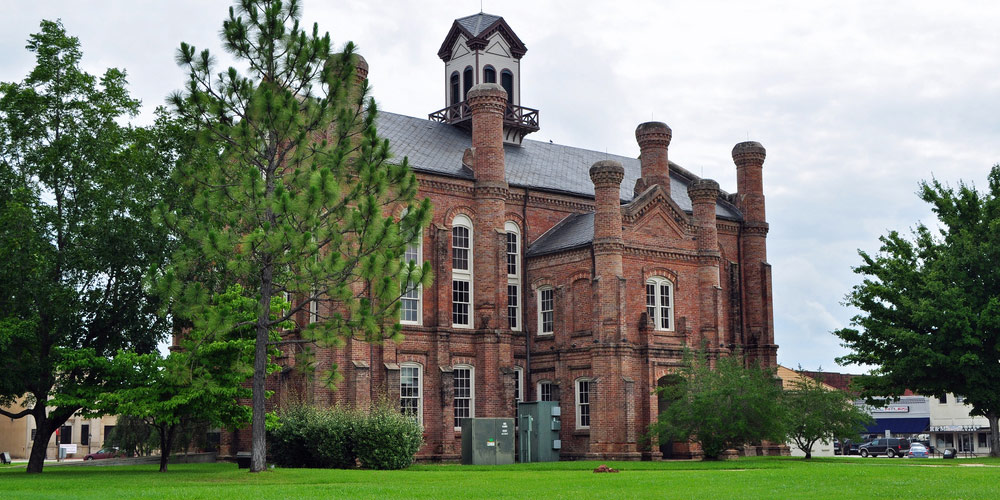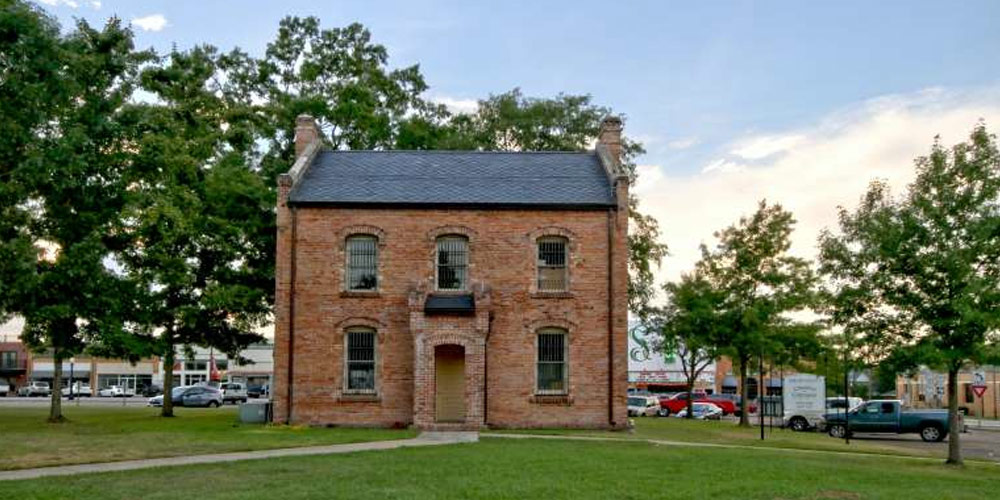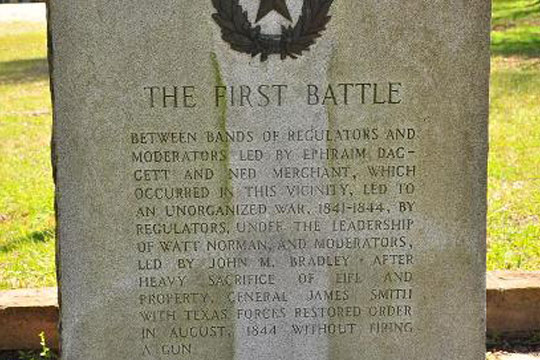Shelby County Court House

Shelby County was established in 1836, and for the next 30 years Shelbyville was the county seat. R.L. Parker, who was county clerk in 1866, decided that the county seat should be in the “center” of the county. That same year, the state legislature passed an act requiring counties to have centrally located seats.
Shelbyville was not so quick to relinquish the county records. So Parker, a man of action, drove an ox cart to the courthouse door in Shelbyville one night and took them. The records were placed under armed guard in a log cabin near the geographic center of the county and the city of Center was born.
A wooden courthouse was built soon after, but all records were lost when it burned in 1882. The courthouse erected in its place is one of the jewels of Center. With stately towers, a cupola, and hidden stairwells, it is an architectural masterpiece. It also has the distinction of being one of the only Texas courthouses modeled after an Irish castle. J.J.E. Gibson, an Irish architect, not only designed the new brick courthouse, but also made the bricks when the commissioners’ court awarded him the contract in 1883.
Shelby County Jail

The Historic Shelby County Jail was designed and buit in 1884 by Irish born architect John Joseph Emmett Gibson. It was one of the first of two brick buildings built in Center, possibly even in Shelby County. It is the epitome of an 1880′s small-town Texas county jail. It compliments the Historic Shelby County Courthouse, also design and built by J.J.E. Gibson. It is now the home of the Shelby County Chamber of Commerce.
Fellowship Missionary Baptist Church

Fellowship Baptist Church, Joaquin, located just off FM Road 139, began with early immigrants to East Texas in the 1830s. The church has a recorded history back to 1839. It was established and pastored by Wyatt S. Childress, who had arrived in the community in 1836. Fellowship is the oldest Baptist church in Shelby County, and the oldest living Baptist church in Texas currently associating with the American Baptist Association. It is understood by common reason that most of the new settlers that came into the territory of Texas crossed either at an Arkansas border or a Louisiana border. Since many of the new people came from Alabama and Georgia, that meant crossing the Sabine River from Louisiana. There were ferries that provided safe crossings for families and livestock.
There are indications that a few settlers had arrived as early as 1818, but they were scattered and no church was started. However, the area of Logan’s Ferry had many springs of water and families found this to be a good place to settle. It was across the river at the Logan Ferry landing that the community of Joaquin was established. Many families just barely got across into Texas and settled near the many springs. While there are no records available to give the exact date of the organization of Fellowship Baptist Church, there is proof of full operation by 1839.
One of the pioneer families was the Childress family. They had at least two sons, George C. and Wyatt S. Childress. George C. Childress is credited with being the main author of the Texas Declaration of Independence. There is a larger than life statue of his likeness at the main entrance to the Five Star Museum at Washington-on-the-Brazos historical site. The earliest reliable records indicate that Wyatt S. Childress was the first pastor and even as late as 1879, he is listed in associational records as the pastor. The early buildings were hewn logs, dirt floor, eight foot fire place, and split log benches with peg legs. After saw mills were brought into the community, a new building with plank flooring and benches with backs was erected.
The Fellowship Baptist Church of Joaquin, Texas, is the oldest, continually active church fellowshipping with Missionary Baptist Association of Texas.
The Regulator-Moderator War
The Regulator–Moderator War was a land feud in Harrison and Shelby counties in East Texas from 1839 to 1844. The feud eventually involved Nacogdoches, San Augustine, and other East Texas counties.
The main leaders were Charles W. Jackson and Charles W. Moorman for the Regulators and Edward Merchant, John M. Bradley, and James J. Cravens for the Moderators. Their differences date back to land frauds, cattle rustling, barn burners, and revenge killings. Dozens had been killed over the years.
The conflict began over fraud, cattle rustling, and land swindling in the Neutral Ground, the lawless area between the American border and Mexican Texas. This conflict reached a boiling point after Charles W. Jackson, a former Mississippi riverboat captain and a fugitive from Louisiana justice, shot one Joseph Goodbread at Shelbyville in 1840. Jackson soon organized a militia he named the Regulators to prevent “cattle rustling.” In turn, the Moderators were organized by Edward Merchant to moderate the Regulators. When Charles Jackson went on trial on July 12, 1841, before Judge John M. Hansford, a friend of the Moderators and Goodbread, the Regulators intimidated the court so much that the trial could not proceed. Open hostilities broke out, resulting in numerous killings and house burnings. Jackson himself and a companion were later ambushed and killed by the Moderators, and Charles Moorman replaced Jackson as leader of the Shelby County Regulators. Moorman, who may have been wanted for forgery in Mississippi, led a party to avenge Jackson and Lauer. They surprised the assassins twenty-five miles north of Crockett. The McFaddens were tried in Shelbyville in October 1841 for the Jackson-Lauer killing, and all were hanged with the exception of the youngest brother.
In the summer of 1844, the Moderators met at Bells Springs and renamed themselves the Reformers. They excluded Bradley and elected James J. Cravens as their leader. They determined to occupy Shelbyville. Republic of Texas president Sam Houston grew tired of the lawless fighting and attempted to settle the matter once and for all. He sent George W. Terrell to investigate the mayhem. Terrell wrote to Sam Houston, “It really appears to me as if society were about to dissolve itself into its original elements”. On 14 August 1844 Houston ordered Travis G. Brooks and Alexander Horton to lead 500 militia into East Texas and make peace between the factions. Brooks was immediately arrested, held, but soon released. Exasperated, Houston himself rode to East Texas and set up headquarters the last two weeks in August at San Augustine to take charge. Through his diplomacy of fairness and even-handedness, Houston was able to get both factions to sign a peace treaty. The feuding groups signed a truce on July 24, 1844, which protected “good and unoffending citizens.” Both factions put aside their differences during the Mexican-American War and joined together with Captain L.H. Mobitt’s company.


